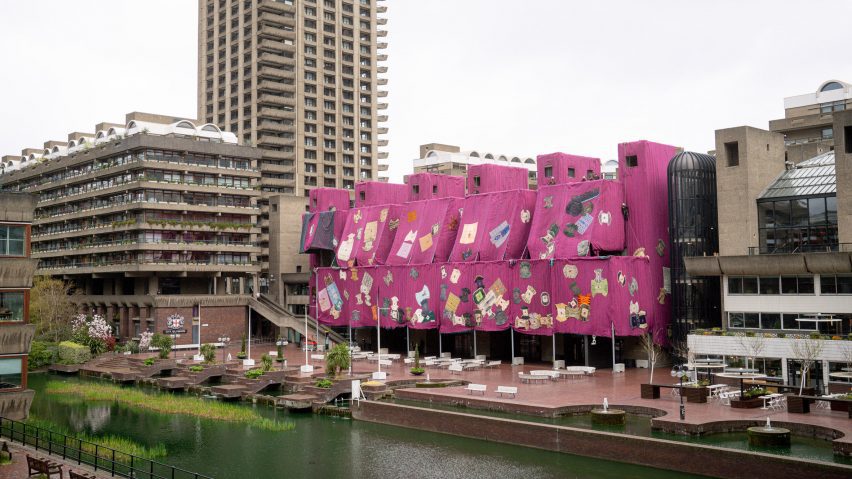Ghanaian artist Ibrahim Mahama collaborated with hundreds of craftspeople to create Purple Hibiscus, a handsewn installation of bespoke pink cloth covering the brutalist lakeside terrace of London's Barbican Centre.
Purple Hibiscus is Mahama's first bright-coloured installation, finished in pink to contrast with London's "grey weather".
"Why not pink?" he told Dezeen at the Barbican. "The building itself is grey and the Barbican is quite grey. And I have never made a work with this kind of colour before, so I thought why not use something quite strong."
"I've never had the courage to use colours like this in public on a large-scale work, but I've been collecting these materials for quite a long time," he added.
Purple Hibiscus, which opens today, is named after Nigerian author Chimamanda Ngozi Adichie's 2003 debut novel of the same name, set in postcolonial Nigeria.
The site-specific installation consists of around 2,000 square metres of bespoke woven cloth, which was hand-stitched together by hundreds of local craftspeople – including students – across the pitch of the Alui Mahama Sports Stadium in Tamale, Ghana.
Mahama and his team then transported the textiles to London, where they currently wrap the facade of the Barbican Centre's lakeside terrace.
"The basic idea was to see what happens when this soft material envelopes the Barbican," said the artist.
Embroidered into the cloth are around 130 colourful batakaris – traditional Northern Ghanaian robes worn by people ranging from royals to ordinary communities, passed down by families over generations.
The striking batakaris were sewn across the textiles like decorative polka dots, embellishing the work with "traditional materials that have histories," explained Mahama.
The artist acquired the robes over time from various people across Northern Ghana, through exchanges or bartering.
"Collecting the individual smocks from communities can be quite challenging, but also opens up a portal of new formal aesthetics," said Mahama.
Mahama's work is often compared to the late artists Christo and Jeanne-Claude, known for their site-specific installations sheathed in industrially produced fabrics.
While the duo has been a significant influence on Mahama for "the quality and the courage that they brought to art forms," the artist's key focus is the historical memories embedded in textiles, he explained.
"I'm more interested in the material history – I'm not interested in industrial machines. Everything is done by hand," said Mahama.
The Purple Hibiscus installation forms part of the Barbican Art Gallery's current exhibition Unravel: The Power and Politics of Textiles in Art.
Last month, a group of artists and collectors pulled their work from the show following the Barbican's decision not to host a lecture series that would have included a talk about the Israel-Hamas conflict by the Indian novelist Pankaj Mishra, criticising the Barbican for "censorship".
Explaining the decision to go ahead with Purple Hibiscus, Mahama said, "I wasn't making the work for myself. It was being produced for the building."
"A lot of labour went into it," he continued, referencing the many weavers and makers in Ghana and the UK who collaborated on the project. "The work was made by a lot of hands."
"I'm coming from a place where we have nothing, and I have always relied on the residual capital of my work to be able to exercise justice in the spaces that I come from," he continued.
Rather than excluding himself from the conversation, Mahama said his interest lies in the contradictions found within art.
"For me, it's not that simple. I'm very interested in the continuation of art and the contradictions that are embedded within it and what it produces," he said.
"I've never really thought to exclude myself from something in order to make a statement. I've always thought to bury myself within it, and then through the contradictions, we can make further statements," the artist added.
"But certainly, I think that freedom of all kinds should be guaranteed everywhere across the world, whether you're from Ghana in a rural area where you don't have access to clean drinking water, or you're in a war-torn zone, where acts of genocide are committed."
Mahama was one of 16 artists who contributed an installation to the Force Majeure exhibition at last year's Venice Architecture Biennale. He was also a part of the Waste Age show at London's Design Museum, which explored how design has contributed to the rise of throwaway culture.
The photography is courtesy of the Barbican.
Purple Hibiscus will be installed at the Barbican from 10 April to 18 August 2024. See Dezeen Events Guide for an up-to-date list of architecture and design events taking place around the world.

